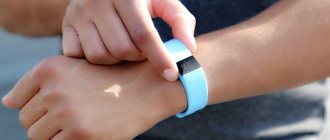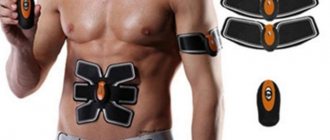What it is
A fitness bracelet is a gadget that, in real time:
- monitors health indicators;
- measures the time spent performing exercises;
- shows the number of steps taken per day and calories burned;
- monitors other parameters necessary for training, weight loss and a healthy lifestyle.
Makes sports more effective. Allows you to track the dynamics of training and weight loss, constantly improving results.
Don't be confused!
Since this is know-how, there is still some confusion in definitions.
A fitness tracker is a broader concept. It includes absolutely all the gadgets (not just bracelets) necessary for the most effective sports activities. This includes applications on phones with the same functions, ordinary wristbands, and complex handheld personal computers. A fitness bracelet is just one of the trackers.
A weight loss bracelet is an ordinary piece of jewelry made of silicone or stones, which is worn on the wrist and affects a person with the power of energy waves. Despite the pseudoscientific principle of operation of such an accessory, Power Balance (one of the brands) was at the peak of popularity at one time.
Smart watches (smart watches, watch phones) are wearable computers that support third-party applications and are controlled by mobile operating systems. They perform the functions of media players, receive phone calls, SMS, and emails.
The table will help you understand the differences between fitness bracelets and smartwatches.
However, recently models have appeared on the market that are difficult to position only as a fitness bracelet or exclusively as a smart watch. This is due to the constant improvement of devices and the intertwining of their main functions.
From the history
1981
The first heart rate sensor was released, which was attached to the athlete's hand. It was distinguished by its large size and numerous wires, which created certain inconveniences in wearing. Especially during training or competitions. Performed a single function.
year 2000
Wireless heart rate monitoring has become available in consumer electronics.
year 2009
The first fitness bracelets appeared, most similar to modern ones. For greater measurement accuracy, they were supplemented with accelerometers and altimeters.
2010
They were taught to analyze the quality of sleep and calculate daily calorie consumption based on data received from the body.
year 2012
Models have appeared on the market that move away from the fitness direction into medicine. They give a signal when the heart rhythm goes astray and becomes pathological, preventing it from stopping. Allows you to monitor vital signs in sick and elderly people. They are actively used by athletes, for whom this data is also important.
Every year, fitness bracelets are improved and equipped with new functions.
Principle of operation
To understand how a fitness bracelet works, you need to understand its structure. Built-in sensors allow you to determine indicators. Depending on the models, there can be from 2 to 10. The more, the more multifunctional the accessory.
Accelerometer
A sensor with a counterweight that responds to body movement. Determines the number of steps taken and speed. Three- and six-axis accelerometers have maximum sensitivity, so they calculate indicators more accurately.
Gyroscope
A sensor that takes into account three-dimensional movement in space. Determines the angle of inclination of the bracelet in relation to the ground. Distinguishes walking from running, exercise and other physical activity.
GPS sensors
Makes calculations even more accurate. Allows you to plot the optimal route for walking or running. Models with the best GPS sensors: Garmin Vivosmart HR+, Samsung Gear Fit2 Pro, Huawei Band 2 Pro.
Heart rate sensor
Sensor with LEDs (working principle: photoplethysmography). Tracks how blood flow changes during different periods of heart pulsation. Controls heart rate during training and at rest.
Pressure meter
A sensor that calculates approximate (!) pressure based on heart rate, taking into account age and weight.
All information collected by the sensors is sent to a smartphone synchronized via Bluetooth with the fitness bracelet. There, in a more convenient format, you can see the optimal duration of sleep for your daily routine, the recommended daily caloric intake and the amount of energy spent, as well as many other points important for playing sports and a healthy lifestyle. How exactly the algorithms work to calculate such indicators is kept secret by the creators.
With the world - one by one. The fact that developers do not explain how calorie content or sleep duration is calculated in fitness gadgets does not always play into their hands. In 2013, a complaint was filed in California against Nike. The company was accused of deception: in advertising they stated that their Fuelband tracker tracks the burning of every calorie during exercise. But studies showed that the device did not take into account either physiological data or the level of activity for the day and always displayed the same number of calories burned. As a result, all Fuelband users were compensated.
Should I shoot at night?
Modern fitness devices allow you not only to track the parameters of training and other physical activity, but also to analyze the quality of your night's rest. In the morning, the owner of the gadget can look at data on the ratio of fast and slow sleep phases, estimate the duration of the night's rest and compare the information with the indicators of previous days. This tracker should not be removed before going to bed.
Most models designed for round-the-clock monitoring of body functioning parameters are adapted to be constantly worn on the wrist.
However, some models of bracelets can cause discomfort at night. Therefore, you should evaluate how the gadget fits on your wrist at the time of purchase.
Benefit
So, what is a fitness bracelet for? The main purpose is to increase the effectiveness of training.
Track activity
With it, you can track your daily physical activity: the number of steps taken, distance in kilometers and calories burned. People who are seriously involved in sports and focused on results (losing weight, building muscle mass, weight control) know exactly how many steps they need to take per day.
If the daily norm is 15,000, but the fitness bracelet shows only 13,000 at the end of the day, you urgently need to go for an extra walk or turn on the treadmill. Otherwise, at the end of the probationary period there will be no result.
It's the same with calories. How can you go to bed if you haven’t achieved an energy deficit during the day? This indicator allows you to decide whether you can eat an extra apple at night or if it’s too much and you’ll have to starve until the morning.
Monitor indicators
A fitness bracelet allows you to keep your physical condition under control: pulse, blood pressure, blood oxygen saturation. Why do breakdowns occur and the initially designed training programs are not completed? Because they incorrectly calculated the intensity - and already at the 5th minute of the lesson, the heart jumps out of the chest and suffers from shortness of breath. And then, after a couple of such experiments, the doctor forbids self-torture. The sports gadget reflects biological indicators and allows you to select a pace so that they remain within the normal range. As soon as your heart rate starts to go off scale, you need to slow down.
Or, for example, the goal of jogging is to lose weight. In this case, it is recommended to keep your heart rate at an average of 130 beats per minute (plus/minus taking into account age, weight and other individual characteristics). If this indicator changes in any direction, the fat burning process will slow down significantly and the workout may be in vain.
Enjoy nice bonuses
Fitness bracelets are loved by many for the additional features that their branded devices provide. For example, all weight loss dieters and athletes know how important sleep is for a healthy lifestyle. However, the general advice to sleep 8 hours a day is not always relevant. As scientists have proven, the duration is determined individually for each person. Plus, you need to correctly calculate when to go to bed and what time to get up, so as not to disturb the deep sleep phase. This gadget will automatically do all this and wake you up at the most opportune moment.
Some bracelets allow you to connect to social networks or create local accounts and post the results of your workouts for everyone to see. Since others are also actively doing this, a competitive moment arises, which provides additional motivation for training. Using this function, you can also find a partner for morning jogging in your city or for visiting a fitness club together.
Thus, fitness bracelets are useful for:
- losing weight;
- training;
- introduction to a healthy lifestyle;
- tracking health indicators.
In principle, we can say that absolutely everyone needs fitness bracelets in order to see specific figures for their daily activity and health indicators. For some, even the laziest, this becomes an incentive to get off the couch and go for a walk or give up their favorite burger.
How can activity trackers affect the psyche?
Some psychologists suggest that the use of activity counters may harm people with certain mental disorders. Trackers are most often mentioned when talking about eating disorders. The urge to adhere to a strict low-calorie diet and exhaustive exercise schedule is one manifestation of such disorders, and it is possible that monitoring may exacerbate this urge.
In 2021, scientists from the British Loughborough University surveyed about 350 people. Those who actively used fitness trackers or eating apps scored higher on the Compulsive Exercise Test and the Eating Disorders Examination Questionnaire (EDE-Q). The more often a respondent used a tracker, the higher their average risk scores were.
According to researcher Caroline Plato, this does not mean that activity meters cause mental problems directly: the interaction of many causes usually leads to the development of the disorder. Careful monitoring of diet and movement may harm people who are already at risk.
Constant monitoring can reinforce obsessive behavior.
Another problem is the ready-made training programs available in many tracker applications: constantly increasing loads do not bring any benefit if the user cannot cope with them.
The authors of the work offer a simple way to recognize the unhealthy influence of trackers. This is an acute feeling of shame or guilt that occurs when the goals set by the program have not been achieved. You should also be wary if you train from time to time not of your own free will, but because “you have to.”
Excessive attention to monitoring can ruin not only eating habits, but also sleep.
In 2021, American scientists reported: in recent years, people have often turned to somnologists concerned that the tracker has negatively “assessed” the quality of their sleep.
Some people continue to worry even when proven methods (such as polysomnography) show that their sleep is fine. Scientists have proposed calling this condition orthosomnia, by analogy with orthorexia - an obsessive desire for healthy eating.
So, fitness bracelets are a promising, but still far from ideal, way to learn more about your own health and physical fitness. However, technology is developing quickly, and perhaps within a few years wearable devices will become much more accurate and efficient.
Built-in functions
The usefulness and multitasking of fitness bracelets depends on the built-in functions. The basic ones for most are:
- heart rate monitor - shows heart rate;
- pedometer - determines the number of steps taken and mileage traveled;
- tonometer - records the approximate pressure;
- calorizer - counts calories burned;
- “smart” alarm clock - gives a signal at the right moment, taking into account the total duration of sleep and its phase;
- sleep monitoring - shows the state of the body at night;
- synchronization with phone.
In conditions of fierce competition, manufacturers equip their devices with numerous additional functions in order to attract as many buyers as possible. These could be indicators:
- water-salt balance;
- blood sugar levels;
- time of taking medications (vitamins, sports nutrition, weight loss products, medications);
- the amount of excess fluid in the tissues;
- percentage of visceral fat;
- breathing rhythm.
With their help you can configure:
- automatic sending of physical indicators to a doctor or trainer;
- remote monitoring of the health of relatives;
- list of goals and objectives, monitoring their achievement;
- reminder calendar.
In 2021, Garmin and Huawei launched a new feature for their bracelets - VO2 Max. It allows you to calculate the maximum amount of oxygen that the body can use during intense physical activity. Based on the data obtained, the gadget adapts to a person’s individual parameters and gives useful tips on which exercises will be most effective and how to properly create a training program.
Those who love swimming can buy a waterproof model that works at depth, in the bath, and while taking a shower. The screen glass can be super durable and protect your device from scratches and shocks. This allows you to use it even if you are into extreme sports.
It should be taken into account that fitness bracelets equipped with only basic functions (with a pedometer and heart rate monitor) are inexpensive. But for each additional option listed above you will have to pay extra.
Types and features of fitness bracelets
Although in most cases the functions of bracelets are almost identical, you can still find many different options on the market, the price of which can vary dramatically. Of course, we should not exclude the commercial side, which forces many brands to compete with each other, trying to capture as much of the market as possible. In order not to become a victim of marketing, you need to be able to distinguish the necessary functions from those that are added to the characteristics of the device “for show”. For example, many popular brands of such smart bracelets focus on the fact that you can not only control the number of calories spent, but also the number of calories consumed.
This is certainly not a useless feature, but in reality it almost never works. The whole point is that to track you need to enter everything you ate during the day yourself. If a barcode scanner helps add calories from eaten candy or cookies, then what to do with cereals, meat and other products? Moreover, even if you enter all the data manually, it will take a huge amount of time, so this function is rarely used to its fullest and can only impress those who want their first bracelet to be as functional as possible.
Another important benefit that is often found on more expensive models is PC compatibility. As a rule, cheap models, such as Xiaomi, allow you to output data only to Android or iOS devices, while Polar, Nike and others can be synchronized with a computer. At first glance, this is not such an important feature, but many users note that hardware for Windows is more stable, and also has the largest number of functions (analysis, comparison of statistics, etc.).
Design also plays an important role. It is important to understand that the device must be worn around the clock, so how the bracelet looks is an important criterion when purchasing. Some manufacturers often manage to combine a bracelet with a watch. Such devices look quite attractive, but the main disadvantage is that the time is displayed vertically. This feature can cause some difficulties, but after some time you can get used to this display on the display. Also, some bracelets have many additional functions, which are not always mandatory. With their help you can control the player, add notifications and use them as an organizer. But all these properties do not in any way affect the main functions of the bracelet and are just a pleasant addition, for which you will have to pay a fair amount.
Advantages and disadvantages
Many people do not understand why spend money on such an expensive accessory if modern smartphones have a wide selection of applications that perform all the same functions. To answer this question, you need to evaluate the advantages and disadvantages of fitness bracelets.
Advantages:
- the data is saved without downloading additional programs (the smartphone will have to be loaded with many applications to perform all the necessary functions);
- data recording occurs unnoticed, without distracting, interfering or causing discomfort (the smartphone should always be carried with you, without letting go of your hands);
- One synchronization per day with a linked phone is enough (the smartphone must be constantly connected to the mobile Internet or GPS, which increases the cost of metered traffic);
- indicators are analyzed over a long period of time and saved (a smartphone can go astray and lose all received data, although this is rare);
- the programs of most fitness bracelets are easily synchronized with a computer/tablet/laptop and quickly open on them;
- lightness, almost weightlessness, which is not felt on the hand;
- long-term work in offline mode;
- functioning in any climatic conditions (even in severe frosts).
Flaws:
- not all models are distinguished by measurement accuracy, which depends on the brand, sensors and compliance with measurement rules;
- high prices;
- not compatible with all smartphone models;
- Too much time is spent tracking results, setting the correct settings, etc.
If saving money is a priority, then mobile applications on your phone that perform the functions of a heart rate monitor, pedometer and other indicators are the best option. If comfort and accuracy of the data obtained is more important, it is better to purchase a fitness bracelet.
Quantity and quality of sleep
In the laboratory, sleep quality is assessed using polysomnography (sleep study) / Mayo Clinic. The sleeper is connected to various machines and his brain waves, breathing, blood oxygen levels and other indicators are monitored.
Fitness bracelets calculate the time and quality of sleep using an accelerometer, which shows how actively you move, and an LED that determines your heart rate.
In one experiment, M. Zambotti, S. Claudatos, S. Inkelis, I.M. Colrain. Evaluation of a consumer fitness‑tracking device to assess sleep in adults / Chronobiology international with the participation of 28 women, Jawbone UP indicators were compared with the results of polysomnography and found that the bracelet overestimated sleep time by an average of 26 minutes, and the time of falling asleep by 5 minutes.
Similar results were obtained in an experiment by M. de Zambotti, FC Baker, IM Colrain. Validation of Sleep‑Tracking Technology Compared with Polysomnography in Adolescents/Sleep in Adolescents. Here, Jawbone UP overestimated sleep time by about 30 minutes and sleep efficiency by 5%.
In both studies, the trackers skipped wake time during night awakenings, counting them as sleep time.
And the more often people woke up, the more gadgets made mistakes.
In another R. Danzig, M. Wang, A. Shah The wrist is not the brain: Estimation of sleep by clinical and consumer wearable actigraphy devices is impacted by multiple patient- and device-specific factors / Journal of sleep research study involving 102 For women, Jawbone and Fitbit Flex trackers added an extra hour of sleep and overestimated its effectiveness by 14%.
As for sleep phases, here fitness bracelets, watches and other smart devices are much inferior to polysomnography. For example, the ŌURA ring, one of the best sleep tracking devices with 96% accuracy, was underestimated by M. Zambotti, L. Rosas, IM Colrain. The Sleep of the Ring: Comparison of the ŌURA Sleep Tracker Against Polysomnography / Behavioral sleep medicine deep sleep by about 20 minutes and overestimated REM sleep by 17 minutes.
In another experiment, Fitbit Charge 2 overrated M. Zambotti, A. Goldstone, S. Claudatos. A validation study of Fitbit Charge 2™ compared with polysomnography in adults / Chronobiology international light sleep by 34 minutes and underestimated deep sleep by 24 minutes.
Analysis of data from four different trackers J. Mantua, N. Gravel, RMC Spencer. Reliability of Sleep Measures from Four Personal Health Monitoring Devices Compared to Research‑Based Actigraphy and Polysomnography/Sensors also confirmed that light and deep sleep times differed from polysomnography measures across all devices.
What is the bottom line: fitness bracelets may well add 20–60 minutes of sleep to you and hide episodes of night awakenings from you. So if the app is telling you to have a great night and you're feeling lousy, it's possible that the bracelet fell asleep while you were walking or tossing and turning.
In addition, you should not rely on bracelets when assessing the number and duration of phases. So far, they have not been able to accurately identify their gadgets.
Kinds
By functionality:
- multifunctional - with additional options;
- with limited functionality - with basic sensors.
By gender:
- female - with an elegant, stylish design, sophisticated, made in bright colors (Smart Bracelet H2 and QW16, Smart Band X6 Metal Gold, A80 Smart Watch, MyPads I9);
- men's - with a discreet, minimalist design, mostly black or dark blue.
Men's and women's fitness bracelets are no different in functionality.
By cost:
- mass market (from $15 to $50): Fitbug, BQ, Xiaomi Mi, Belsis;
- middle market (from $50 to $120): Jawbone, Huawei TalkBand, GearFit, Sony;
- premium (above $120): Fitbit, Mio Fuse, Samsung Gear Fit2 Pro, Polar A360 HR (Russia).
It is impossible to differentiate between smart trackers that are used exclusively for training and those that help you lose weight. All models combine both functions.
Purchase and cost of devices
These devices can be purchased on specialized websites, ordered using an order form or in sports stores.
Their cost depends on the manufacturer, the number of functions, and design. On average, the price ranges from $100 and above. For example, the base model Magellan Echo is about $150 plus a $50 heart rate monitor.
Each tracker has its own positive and weak sides, but when choosing, you should focus on those aspects that you need. Of course, when choosing this device, you can focus on any of its qualities, which play a key role in the eyes of the buyer; someone will be interested in a new fashionable model, for someone the design is important, for someone a single function is important. But it is better to give preference to a tracker rich in a variety of applications that may become necessary for you in the future.
Criterias of choice
Fitness bracelets on the modern market are presented in a wide range. Therefore, a logical question arises: which one to choose, so as not to overpay for the brand and unnecessary functions. First, decide for what purpose the accessory is needed and what indicators matter. If you don't work with heart rate, a built-in heart rate monitor is optional. If you play sports simply to maintain physical fitness and are not on a diet, there is no need for a calorizer. When viewing the functionality, pay attention to these points.
Main criteria
- The more built-in sensors, the more multifunctional the fitness bracelet.
- A three- or six-axis accelerometer provides greater accuracy.
- The presence of a screen is a convenient option, unlike models that display information only on a smartphone.
- Shockproof, heavy-duty screen.
- Charge duration: there are models that last for a month of uninterrupted operation, and there are those that will have to be recharged every 3-4 days.
- Availability of additional features (maintaining a personal account, reminders).
- Design. Choose the color of the strap that you like and that fits into the overall style.
- Compatible with smartphone model.
- Availability of several training modes (most often depending on the pace and type of sport).
- Simplicity of the interface.
Waterproof
Separately, it is worth mentioning water resistance. It is important not only for swimming enthusiasts. There is always a risk of getting caught in the rain or forgetting to take off your bracelet before taking a shower. Therefore, it is better to choose models that are protected from water. Fitness trackers have several classes of water and dust resistance. You need to be able to understand them in order to purchase a truly high-quality accessory. The table will help with this:
Not all manufacturers use the International Protection Marking data presented in the table, despite the fact that they are regulated by IEC standards (DIN, GOST). As an alternative, WR (Water Resistant) and ATM (atmosphere, pressure) indicators are sometimes used. If the instructions indicate these letter abbreviations, you should use another table:
Functionality
The following table will provide assistance in choosing fitness bracelets, taking into account your preferred sport, goals, built-in sensors and additional functions:
Compatibility
Fitness bracelets only function in tandem with smartphones. Therefore, when purchasing, you should definitely pay attention to whether the gadget is compatible with your phone’s operating system - iOS or Android. Review of applications for smooth operation of trackers:
General comparative analysis of some models according to different criteria
Why do we need constant activity monitoring?
The first wearable trackers were created for professional athletes - they tracked heart rate and other indicators to better calculate loads. Today the situation has changed: many of those who wear trackers are far from athletes.
Much more often, such accessories are purchased by people who lead a mostly sedentary lifestyle. Their goal is to find out how much time they spend immobile and take the first steps towards sports. For example, participants in a small Australian study were most likely to start wearing a tracker to get a more accurate picture of their activity and to improve their fitness and health. Other motives, such as the desire to look better or a passion for new technologies, were much less common.
Lack of movement is indeed considered dangerous. Many studies link a sedentary lifestyle with an increased likelihood of developing obesity, heart and vascular disease, and type 2 diabetes. The psyche also suffers from inactivity: those who spend their days at the table and evenings on the couch are more likely to face depression. According to the World Health Organization, in 2008, 31% of the world's adults lacked physical activity.
Physical inactivity has many causes. People are increasingly not only working, but also relaxing while sitting: who hasn’t at least once spent a day off watching a TV series? The entertainment industry willingly takes advantage of this: for example, the streaming service Netflix has been releasing all episodes of new seasons of shows on the same day since 2013. 61% of participants in a survey conducted by the service admitted that they regularly watch several episodes in a row. Another problem, WHO says, is the infrastructure of many cities. Sometimes their residents simply have nowhere to go: there are not enough parks and squares, and in some places there are not even comfortable sidewalks - the only way to get around comfortably is by car.
However, even if all the conditions are created for walking and training, sometimes you still don’t want to get up from the couch. This is where a fitness tracker should come to the rescue.
Research shows that regularly tracking your activity can help you lead a healthier lifestyle, including moving more.
With a fitness gadget, monitoring your habits becomes much easier - actions are recorded automatically. In addition, trackers allow you to turn everyday life into a game: developers are constantly looking for new ways to gamify everyday tasks.
How to use
How to turn it on:
- After purchase, put it on the charger that comes with the kit. After this, the bracelet will turn on automatically.
- Install a special application on your phone via Google Play Market or AppStore.
- Open, log in, find the pairing screen and select your tracker from the available ones.
- Synchronization will take some time, after which you will receive a notification that the pairing process is complete.
- After this, you can set the desired settings.
How to setup:
- Indicate the hand on which the bracelet will be worn. The accuracy of its work depends on this.
- Check the boxes next to the parameters that will be displayed. Mark only those that need to be worked on. If you don't count calories, you don't need them. If you do not monitor your heart rate, remove the mark.
- Set the time format if there is a clock. If you are keeping track of time, make them larger and brighter.
- Activate the bracelet to turn on when you raise your hand. This will increase battery life.
- Select when it is convenient to track your heart rate: only during sleep, only during training, or constantly.
- Enable or disable sleep monitoring and smart alarm clock.
- In some models, you need to work with settings for notifications about calls, SMS, goal achievements, and applications. Determine which ones are important and which ones should be discarded.
It is more convenient to set the settings through the mobile application immediately after installation on the phone.
How to wear:
- Wear on your less active hand for more accurate results. Right-handers - on the left, left-handers - on the right.
- Don't change hands.
- If you have a heart rate monitor and blood pressure monitor, wear it at a distance of 2-3 cm from the palm so that the LEDs that track your heart rate and pressure pass over the line of blood vessels.
- The capsule (back side of the screen) should fit snugly to your hand.
- At the same time, do not tighten the strap too tightly - this may distort the accuracy of the data obtained.
- Once a day it is necessary to remove it to allow the skin to breathe. This is especially true for silicone devices, under which moisture often accumulates, causing irritation and erosion.
- A regular watch should be positioned above a fitness bracelet.
- Simultaneous wearing of a fitness bracelet, a regular watch and jewelry made of any metal is not prohibited.
Fitness bracelets must be regularly cleaned with special aerosols, as they come into contact with pathogenic microorganisms on the skin, micro-discharges, and then can become a source of infection. The rules on how to do this are usually described in detail in the attached instructions. If a branded cleaning liquid is not available, a soda or soap solution can be a substitute.
It is also worth regularly checking the straps for signs of wear and tightening the screws, if any.
Devices with heart rate monitor
A fitness watch with a heart rate monitor will give you more detailed information in this direction. Naturally, when you do, for example, fitness dancing, the presence of a stopwatch or timer is important for you, but a heart rate monitor is even more necessary. A heart rate monitor
is a device that records the heart rate; it measures the pulse and reports its frequency to the owner.
The device is compact in size and folds into two halves.
- The first part is a sensor
, it is placed on the chest or arm. Using two electrodes, it controls the number of impulses received from the heart and detects the potential difference on the surface of the hand at the same moment, thereby identifying the pulse rate. - The second part is the receiver
located in the device. It is there that information about all the heart rate monitor calculations is received and the person sees everything on the dial.
Today, a heart rate monitor is available not only to professional athletes, but to people who want to know everything about their health. In connection with this, heart rate monitors are ultra-precise with additional information and for sports. This device will help you see the real picture of the effectiveness of exercise on a fitness mat, and there is no need to take time off from your workout.
Ratings
Overall TOP 10:
- Samsung Gear Fit2 Pro (Vietnam). $200.
- Polar A360 HR (Russia). $150.
- Fitbit Charge 2 (China). $140.
- Sony SmartBand 2 SWR12 (Japan). $90.
- Garmin Vivofit 3 (USA). $70.
- Huawei Honor Band (China). $70.
- Amazfit Cor (China). $50.
- Jawbone UP24 (USA). $45.
- Xiaomi MiBand 3 (China). $30.
- Iwown i6 HR (China). $25.
The best fitness bracelets for sports:
- Huawei Fit is an ideal choice for runners.
- Fitbit Flex 2 is a versatile device that allows you to work in different sports, including swimming.
- Asus ZenWatch 3 is a tracker for professional athletes whose workload is maximum.
- Garmin Vivosport is a smart bracelet for the laziest, as it motivates to move more.
- Xiaomi Mi Band 3 is an economical but multifunctional device suitable for beginners.
Best choice for weight loss:
- Fitbit Flex - help in creating cardio programs
- Jawbone UP3 - an opportunity to lose weight without harm to your health.
- Garmin Vivosmart HR is a multifunctional weight loss gadget.
- Sony SmartBand 2 - tuned to reduce weight.
The best fitness bracelets with blood pressure measurement:
- Smart Band M3.
- Jet Sport FT-7.
- QS 100.
- Gsmin WR32S.
- ZDK i8.
- Smart Bracelet M2.
- Gsmin C1 Plus.
- KaiHai H66 (sold on Aliexpress).
- Bizzaro F330 (best value for money).
- Qumann QSB 08 (lightest and most compact).
The newest fitness bracelets (best sellers in 2021):
- Samsung Gear Fit2 Pro. $200.
- Fitbit Charge 3. $170.
- Polar A370. $160.
- Garmin Vivosmart HR+. $150.
- Huawei Band 3 Pro. $70.
- Garmin Vivofit 4. $70.
- Amazfit Cor. $50.
- Honor Band 4. $40.
- Xiaomi Mi Band 3. $30.
- Honor Band 4 Running Edition. $25.
The production of modern fitness bracelets can only be compared with the release of new iPods. In conditions of fierce competition, brands try to regularly update models, equipping them with numerous additional functions. Those who cannot imagine life without this “smart” and useful gadget constantly monitor the release of new products.
How does a smart alarm clock work?
To make waking up pleasant, most of the models provide a function such as a “smart alarm clock”. It allows you to identify the most appropriate moment to wake up by monitoring the change in sleep phases. The most favorable phase for awakening is the REM sleep phase, when the state of the human body is similar to the state during wakefulness. When you wake up during the REM phase, you will not feel tired and want to go back to bed.
If you need to wake up at a specific time, just specify the time range. From this segment, the device will independently select the most suitable moment to wake up. For example, if you need to arrive at work by nine in the morning, you can select the time period from 7:00 to 7:30. Then the bracelet will wait for the onset of the fast sleep phase within the specified period of time and, as soon as this happens, the alarm will go off. If the REM sleep phase never occurs, the alarm will go off at the very last moment, that is, at 7:30.
The best fitness bracelets with a smart alarm clock
Useful gift
By the way, not so long ago I gave a tracker to my uncle, who is already quite elderly. No, he is not an athlete, but he takes care of his health. And the new gadget helps him a lot - the man strives to achieve the recommended number of steps per day.
That's why he walks a lot. Measures your pulse, improves your sleep and even monitors your heart. In the summer I even swam in the lake wearing the bracelet; it was interesting to check its water resistance. In general, for my uncle, the tracker turned out to be both a healthy thing and a new, interesting hobby, which I am very happy about!
By the way, you can buy yourself a high-quality fitness bracelet (until February 1, 2021 at half price with free delivery via the link). You can also compare prices and choose a suitable bracelet in the Yandex market.










